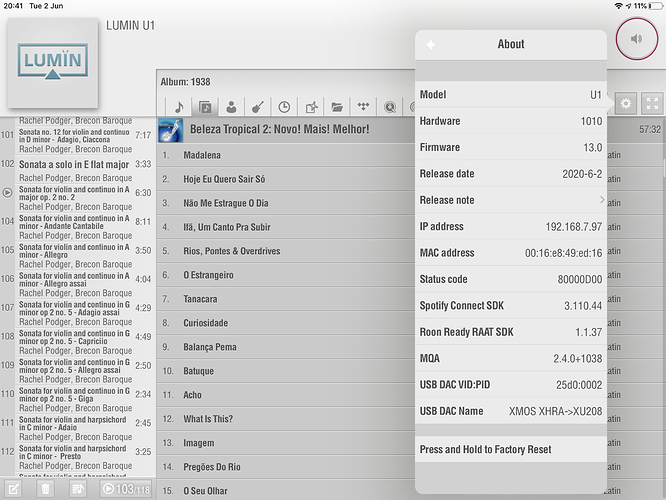Before I start pulling my system apart I’ve asked Bricasti for comment.
One last check. Please make sure the Lumin Volume Control is disabled, and Custom Re-sampling is Off.
Yes, checked.
Bricasti has responded that DSD256 is only native, not DoP. What does that mean for Lumin settings?
Please confirm it is using XMOS (if not, tell me which USB chip it uses), and tell me the USB VID and PID values. Having these information is necessary (but may not be sufficient) for Linux native DSD output.
Is there a Windows driver for it? Native DSD256 should require a Windows driver for Windows users, but I can’t find it.
So far all I know from a post on another site is “The MDx is based on one of the latest Analog Devices Dual Core Sharc DSPs,”. I hope to have more info from Bricasti after the weekend. One thing I’ve discovered in messing about is that on AES, redbook is much better on the Bricasti than upsampled by Roon to DSD64 on DoP which just quenches the soundstage and the dynamic range.
The Sharc is probably not the USB chip.
I think there is a setting in M3 to control the DSD conversion mode. If I understand correctly M3 has two completely different internal paths for DSD playback, so you can get two different flavors of DSD playback. It should default to DSD, see if you can select it to DSD PCM. Do the comparison again, see if redbook still sound better to you than DSD upsampling from Roon.
Yes, thanks, I’ll try that. I live in the Chicago Loop, so I’m been distracted over the past couple of days.
Checked it out - still prefer non-upsampled, even adjusting for volume. Attack and throatiness of brass section significantly better. I guess at some point I’ll see if the same holds for USB. No response yet from Bricasti, who may have better things to be doing when coping with present conditions.
I’ve sent you a pre-release firmware with specific support for Bricasti added.
See if DSD256 work for you. And please find the USB VID PID from the Lumin app - About function of U1.
I thought I had responded to this but must have messed up somehow. So, yes, the new firmware works perfectly and I’m so grateful for your extraordinary responsiveness.
Great, please show a screen capture of the Lumin app about function of your U1. I added some USB DAC information to that screen for your case.
btw, the option to select digital output has been removed – does this mean it’s fine to leave both AES and USB cables connected to DAC and to select via the DAC input selector?
That’s a bug with the Lumin app version you’re using. I’ll have it fixed ASAP.
With USB output connected to a USB DAC, only the USB audio output is correct. The other outputs do not have correct audio timing. When using AES / BNC / coaxial / toslink output please disconnect the USB.
Thanks for the screen capture.
Please update Lumin app to 6.1.17.
Thanks – done.
It’s huge…
I’m one of the guys who was actually curious about this comparison (U1 vs U1 Mini+S Booster). I have both units and I thought it would be useful to share my experience with the two units to help potential buyers.
I can safely say to just don’t bother with the U1 Mini if you have the funds, just go for the big brother U1. The difference is so noticeable that it’s not even worth comparing them, the U1 is simply better - better resolution and clarity, wider and deeper stage, blacker background, greater instrument separation, greater refinement…in a nutshell I would say that the U1 makes the U1 Mini sound “strained”.
The U1 Mini+S Booster combo is a serious step up from regular computer streaming and it beats most streamers at the same price range currently available on the market but it doesn’t hold a candle against its big brother, the U1.
I’ll be putting the combo up for sale in a few days, so that it can find a new home where it will get some love, otherwise it will turn into a great dust collector.
Thanks for sharing your experience.
Besides the external LPSU, is there any difference in the streaming components of the U1 and the U1 Mini? The software at least is identical, isn’t it?
- external LPS vs internal SMPS. 2. Heavy aluminium chassis for mechanical stability and shielding. 3. DSD512 (Linux native DSD only) vs DSD256.
